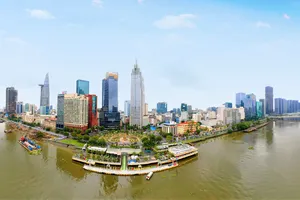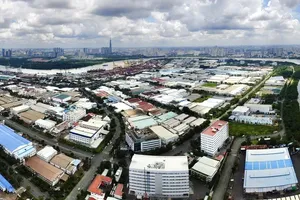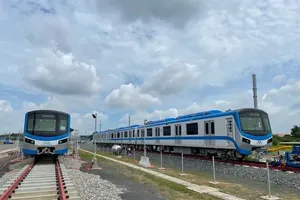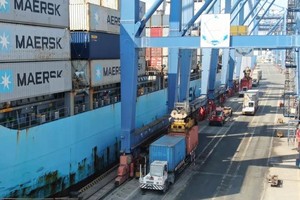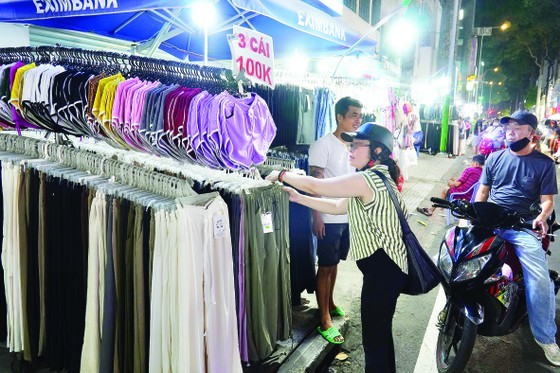 |
Sidewalk encroachment for clothing sale in Nguyen Trai Street, Ward 3, District 5, Ho Chi Minh City in the evening of July 11. (Photo: SGGP) |
Self-assumed sidewalk ownership
Although the sidewalk is a public facility, many street frontage homeowners assume it belongs to their ownership, and thus are ready to accuse anyone of trespassing on the sidewalk in front of their house, or even rent it out. In fact, this situation has existed for a long time on many roads in HCMC.
In particular, on Be Van Dan street, every morning, Pho Cam restaurant (30 Be Van Dan Street, Ward 14, Tan Binh District) sets up tables and chairs occupying the sidewalks of three adjacent houses, with motorbikes dominating both the sidewalk and the roadbed. The restaurant staff, however, viewed this phenomenon as justifiable, as every month, the owner of the restaurant has to pay the rent for the sidewalk in front of the house. According to him, the restaurant has been in business for a long time, and sometimes they can be fined if customers are found to park their cars on the road, but it does not matter if the staff reacts quickly enough to relocate the cars as soon as the authorities arrive.
Even in the central districts such as District 1 and District 3, the owners of many street frontage houses also assume that they own the sidewalk in front of their house. Typically, the sidewalk along Hai Ba Trung Street (the area near Tan Dinh Market, District 1), or the section from the roundabout of Duc Thanh Tran monument to the foot of Kieu Bridge are both encroached for business. Phan Xich Long Street (Phu Nhuan District) is known as the "food street", as most of the sidewalk area has been packed with advertising boards by restaurants or used for parking. A similar situation can be seen on Truong Son Street (Ward 15, District 10), where most of the food stall owners have to pay the rent for the sidewalk.
According to Sai Gon Giai Phong Newspaper’s reporters, the sidewalk rental ranges from US$84 to $168 (VND2 to 4 million) per month, depending on the size as well as the specific use.
Security guards of many buildings even do not allow parking on the sidewalk. Examples of this include DNA International Hospital, located in the corner of Tran Hung Dao and Nhieu Tam streets, District 5, or the building located on 343 Pham Ngu Lao Street, District 1, where the guards even place a sign prohibiting parking on the sidewalk, treating the sidewalk as part of the building.
A race among street vendors
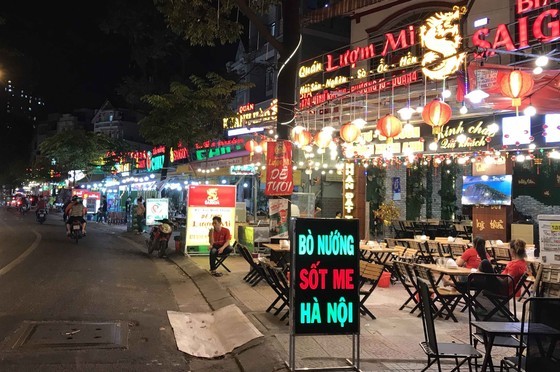 |
The entire sidewalk of Vinh Khanh Street (District 4) is encroached for business (Photo: SGGP/ Hoang Hung) |
Street vendors are ubiquitous on most roads. Every morning, Tan Son street (Tan Binh district) is always congested, but the street vendors selling coffee and breakfast still manage to secure their places by occupying the sidewalk, right in the convergence of two streets. Similarly, the area in front of Tran Boi Co Secondary School (District 5) has long been a business place for street vendors every evening. The sidewalk around Tran Phu Secondary School (Truong Son Street, District 10) even installs a large light bulb to illuminate the vendors throughout the night.
Except for the noon, the sidewalk and the space in front of Le Thi Rieng Park (District 10) become a business place for many street carts all day. In the evening, food trolley owners even set up tables and chairs for passengers to sit in front of the park. Nguyen Hue Walking Street (District 1) after 10 pm also becomes a place for street vendors, lasting until dawn. Surrounding the International Square (District 3) emerge street carts when the sun goes down. Even the reading space in the evening is encroached to sell coffee. More importantly, the densely placed signs prohibiting the gathering of street vendors are even outnumbered by the food carts. Similarly, in the evening, the sidewalk of Bau Cat park (Tan Binh District) is mostly used for pub business and selling mixed rice paper.
Proposal to collect sidewalk fee
There are 12 million square meters of sidewalks in HCMC; therefore, a large sum of money will be yielded if a user fee is collected. According to the draft of the project to collect tolls for the temporary use of roadbeds and sidewalks in HCMC by the Department of Transport of Ho Chi Minh City, the department has proposed 5 toll areas in many different locations, based on comparison with the average land price in the area.
Accordingly, people who temporarily use the roadbed and sidewalk in the area will have to pay a fee of $2 to 15 (VND50,000-350,000) per square meter per month depending on the location. In area 1 (roads with an average land price equal to or higher than $1,520 (VND36,812,000) per square meter), the central route used to park cars and motorbikes can be rented at $15 (VND350,000) per square meter, and other routes at $7.6 (VND180,000) per square meter.
For other activities, except for parking, the price is from $2 to 4 (VND50,000-100,000) per square meter. Area 2 (land price equal to or higher than $577 (VND13,659,000) per square meter) includes the central road with the rental price of $4 (VND100,000) per square meter, and other roads with the rental price of $3 (VND70,000) per square meter.
For area 3 and area 4, the rent is from $2.5 (VND60,000) per square meter. Area 5 has the same rental price on all routes at $2 (VND50,000) per square meter.
Sidewalks in front of and along the Heart Hospital, People's Hospital 115, Children Hospital No.1 (District 10), Cho Ray Hospital, University of Medicine and Pharmacy Hospital, Pham Ngoc Thach Hospital (District 5) have long been a place of business for many people, especially street vendors. Although the functional forces regularly patrol and punish acts of encroaching sidewalks and causing public disorder, the situation remains rampant.
In fact, there are also many situations where the house owner and the sidewalk renters dispute over the communal space. Mr. H., who is renting a house for business on Nguyen Trai Street (District 5), failed to require the street vendors in front of his house to move to another place as they claimed the place public sidewalk, and thus refused to move unless the authorities asked them to do so.
Mr. Hoang Minh Tri, Former Deputy Director of Ho Chi Minh City Development Research Institute:
Reasonable plan for sidewalk use in demand
If implemented, the sidewalk fee scheme of Ho Chi Minh City will not only provide the State with revenue to reinvest and improve sidewalks, but also help business people feel secure to operate. However, to do this, the State needs to have a specific plan on the reasonable use of sidewalks. For example, sidewalks with a width of 3m or more can partly be reserved for a business and the rest for pedestrians.
The sidewalk fee should only be applied to people with business premises, while street vendors should be supported with a stable business place, as most of them are from disadvantaged backgrounds. On the contrary, the management of food safety with street vendors is crucial for people's health.
The arrangement of business locations for street vendors should be taken into careful consideration, so that they can still be accessed by their target customers after relocating. On the other hand, street vendors can hardly flourish in the rainy season; therefore, the new business place should be conveniently designed and covered, incentivizing them to better comply with this arrangement.
Currently, many roads have been installed with security cameras, which facilitates the management of sidewalk encroaching behaviors.
Architect Ngo Viet Nam Son
Pedestrians take priority
First, pedestrians must be given priority. In the interest of safety, the pedestrian part must be the one close to the house, and renting is only available on the sidewalk that is wide enough. The rental section can be painted blue for a clear boundary. Sidewalks with infrastructure such as electricity and fiber optic cables can be painted red so as not to be infringed. Sidewalks should be numbered and posted on the city's public information system for transparent management.
Sidewalks can be rented in shifts or for a whole day, as long as it must be clean and tidy in return. Further research about what types of businesses are allowed on the sidewalk to maintain the urban beauty should also be conducted. In particular, the cultural route can be catered for the correspondingly suitable businesses, while the cuisine street can be used for street vendors. However, it is worth noting that business rental of any form requires the consent of the house owner on the sidewalk.
For street vendors, many countries in the world have a place for them to do business for free, but after doing business, they must also clean up. The space in front of hospitals, and schools can also be rented out, as long as the pedestrian path remains.

